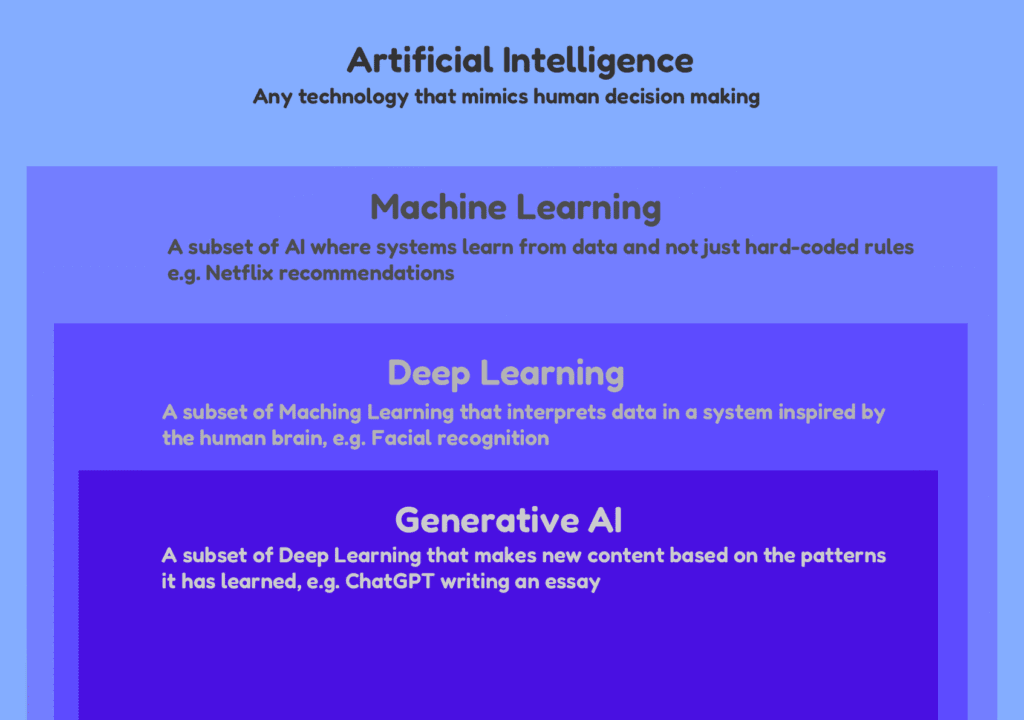Feeling a little left behind? It’s ok, things moved fast. ChatGPT didn’t even exist before late 2022 (!!!!) and suddenly the internet is full of robot poets, fake celebrity photos, and people asking AI how to boil eggs. This is your crash course to get up to speed.
What is AI, Actually?
AI (that’s Ai not A1) stands for Artificial Intelligence, but this is a broad term for a lot of different types of technology that can mimic human reasoning and problem-solving. This includes everything from voice assistants to spam filters to those eerily accurate “you might like” suggestions.
Most of what people mean when they talk about AI in 2025 is really machine learning, a type of AI where systems learn from a ton of data. Like, a TON (hundreds of billions of words.)
The current hype is around generative AI, which is where ChatGPT falls. As opposed to older systems that just sorted or predicted, generative AI can create brand-new content. This could be text, images, sound, and even videos or code.

What is AI Used For Today?
There are many AI assistant tools available directly to the public, including ChatGPT, Microsoft Copilot, Google Gemini, Claude AI by Anthropic, and Perplexity AI. These are kind of “all purpose” tools, with many others that specialize in particular areas like only images or law contracts.
Most business software has been racing to integrate “AI-powered” features into their existing software, from writing emails in Gmail to summarizing job applications in hiring software. You’ll also see AI used in customer service bots, writing assistance, content creation, data analysis, and even coding. We’re not quite at “robot takes your job” levels, but we are firmly in “robot makes suggestions in your inbox” territory.
Is AI Dangerous?
The short answer: not really. The long answer is that it depends how we use it.
There are different ways to think about the impacts of AI. Some people are worried about AI causing job losses. Others are worried about the electricity demands to run the computers behind AI because it takes a LOT of power right now.
The most direct dangers might be in spreading misinformation. Just recently, fake pictures of Katy Perry at the Met Gala spread online, but there have been more serious concerns about election interference too.
Companies are trying to fight this in various ways, with automatic detection, AI watermarking, and special “AI generated” labels on shared content. Researchers also actively work on “guardrails”, which are rules for what the AI can and cannot do, to keep things safe.
How To Be A Smart Consumer of AI
Would you be fooled by this? If you scrolled by quickly?

What about this? Which one is the real (bougie) deviled egg?

What to look for:
- Weird shadows or lighting
- Strange text or gibberish labels
- Fingers, teeth, or eyes that don’t look quite right
- Over-smooth or “hyper-real” textures
But sometimes it’s hard to tell. Before sharing something, try doing a quick online search to fact check, especially if it’s something that seems pretty surprising. Usually any viral misinformation will have a top Google result debunking it.
By the way, which egg was real? The middle one. And it was delicious.How To Be A Smart AI User
Step one: actually try it.
Tools like ChatGPT, Claude and others have limited free plans and it’s $20/month beyond that. To be the most functional human you can, you should try to embrace new technology and understand its benefits and limits.
AI works best when you guide it well. That means giving it a good set of instructions (that’s called a prompt.)
Here’s how to do it (this is prompt engineering):
- Be specific: what are you trying to do?
- Tell the AI what role it is playing: are they a helpful friend or a picky editor?
- Give examples: what should their response contain?
- Specify the format you want: is it a table, a list, or a 5 page story?
- Add any limits or specs you can think of: tone? length? audience?
This will work but might not be perfect:
edit this paper
This is a lot better and didn’t take much more effort:
I am writing a paper for 8th grade about Rosa Parks. Act like my teacher grading my paper. Give feedback on things like run-on sentences or grammar mistakes. Give me a bulleted list of improvements, but no more than 5-10 bullets.
And if it doesn’t quite work? Ask it to try again with more guidance:
I really like the structure and the length but make it sound less formal.
You’ll quickly find uses that help. Maybe copying and pasting an entire recipe to ask AI to rewrite it for more people, or to accommodate a particular diet. Trust, but also verify. You wouldn’t want to paste a cover letter for a job without taking out parts that say {insert your name here}. Plus, there’s a phenomenon called hallucination that means sometimes it will just… lie. If only we could get away with the same thing at work.
Final Thoughts for the Future of AI
Nobody knows exactly what the future will look like, which is why you’ll keep seeing wild headlines. Some jobs will be impacted. Others will evolve. Entirely new roles will be created. This isn’t the first tech wave, and it won’t be the last.
Be curious, be cautious, and find ways to use AI to supercharge your life. Like any tool, it’s most useful in the hands of someone who knows when to trust it and when to raise an eyebrow.

Good article. AI has been a bit of a mystery, this article helped to provide a nice overview of basic definitions and different types of artificial intelligence.
I use Microsoft copilot for general AI stuff & copilot 365 for translation and office related things. I use adobe acrobat pro AI assistant for pdf related things, and adobe firefly for generative AI photos and videos. I’m still learning how to use all the AI features I pay for.